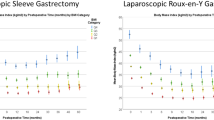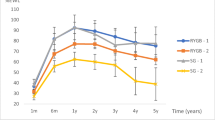Abstract
Background
The measurement of weight loss after bariatric surgery is under constant review in order to obtain the ideal standard for reporting weight loss. Several formulas have been proposed for this purpose. Our goal is to analyse weight loss after sleeve gastrectomy, with or without antrum preservation through different measurement formulas.
Methods
A prospective randomised study of 60 patients (30 patients with initial section at 3 cm from pylorus and 30 patients at 8 cm from the pylorus). We calculate the following variables at 3, 6 and 12 months from surgery: BMI, excess weight loss (%EWL), percentage of excess of BMI loss (%PEBMIL), expected BMI, % PEBMIL corrected by EBMI and percentage of total weight loss (%TWL).
Results
Weight evolution is similar in both groups, reaching a mean BMI of 33.62 ± 4.35 and 34.48 ± 4.23 kg/m2 respectively 12 months after surgery, closer to expected BMI. TWL follows the same trend, with losses exceeding 30%, although 3 cm group is above the tables of percentiles made with our series. Regarding PEBMIL, the 3 cm group reaches 67.8% classified as excellent, while 8 cm group reaches 62.8% classified as a good result. EWL situates the best results for 3 cm group.
Conclusions
Group 3 cm obtained a lower percentage of suboptimal results using EWL. %TWL places the 3 cm group in higher percentile than 8 cm group. Through EBMI, both groups are equally effective. It is necessary to have standardised dynamic tables for each surgical technique, becoming essential elements to measure weight loss after surgery.




Similar content being viewed by others
References
Deitel M. How much weight loss is sufficient to overcome major co-morbidities? Obes Surg. 2001;11:659.
Baltasar A, Serra C, Bou R, et al. Índice de masa corporal esperable tras cirugía bariátrica. Cir Esp. 2009;85(5):308–12.
Baltasar A, Perez N, Serra C, et al. Weight loss reporting: predicted body mass index after bariatric surgery. Obes Surg. 2011;21(3):367–72.
Van de Laar A. Bariatric Outcomes Longitudinal Database (BOLD) suggests excess weight loss and excess BMI loss to be inappropriate outcome measures, demonstrating better alternatives. Obes Surg. 2012;22(12):1843–7.
Van de Laar A, de Caluwé L, Dillemans B. Relative outcome measures for bariatric surgery. Evidence against excess weight loss and excess body mass index loss from a series of laparoscopic Roux-en-Y gastric bypass patients. Obes Surg. 2011;21(6):763–7.
Brethauer SA, Kim J, El Chaar M, et al. Standardized outcomes reporting in metabolic and bariatric surgery. Obes Surg. 2015;25(4):587–606.
Halverson JD, Koehler RE. Gastric bypass: analysis of weight loss and factors determining success. Surgery. 1981;90:446–55.
Lechner GW, Elliot DW. Comparison of weight loss after gastric exclusion and partitioning. Arch Surg. 1983;118:685–92.
Braghetto I, Davanzo C, Korn O, et al. Scintigraphic evaluation of gastric emptying in obese patients submitted to sleeve gastrectomy compared to normal subjects. Obes Surg. 2009;19(11):1515–21.
Abdallah E, El Nakeeb A, Youssef T, et al. Impact of extent of antral resection on surgical outcomes of sleeve gastrectomy for morbid obesity (a prospective randomized study). Obes Surg. 2014;24(10):1587–94.
Elosua R, Garcia M, Aguilar A, et al. Validation of the Minnesota Leisure Time Physical Activity Questionnaire in Spanish women. Investigators of the MARATDON Group. Med Sci Sports Exerc. 2000;32(8):1431–7.
1983 Metropolitan height and weight tables. Stat Bull Metrop Life Found. 1983;64(1):3–9.
Alastrué A, Sitges A, Jaurrieta E, et al. Valoración de los parámetros antropométricos en nuestra población. Med Clin (Barc). 1982;78:407–15.
Baltasar A, Bou R, Del Rio J, et al. Cirugía bariátrica: resultados a largo plazo de la gastroplastia vertical anillada. ¿una esperanza frustrada? Cir Esp. 1997;62:175–9.
Van de Laar AW, Acherman YI. Weight loss percentile charts of large representative series: a benchmark defining sufficient weight loss challenging current criteria for success of bariatric surgery. Obes Surg. 2014;24(5):727–34.
Sánchez-Santos R, Masdevall C, Baltasar A, et al. Short- and mid-term outcomes of sleeve gastrectomy for morbid obesity: the experience of the Spanish National Registry. Obes Surg. 2009;19:1203–10.
Sczepaniak JP, Owens ML, Shukla H, et al. Comparability of weight loss reporting after gastric bypass and sleeve gastrectomy using BOLD data 2008–2011. Obes Surg. 2015;25(5):788–95.
Abd Ellatif ME, Abdallah E, Askar W, et al. Long term predictors of success after laparoscopic sleeve gastrectomy. Int J Surg. 2014;12(5):504–8.
Dorman RB, Rasmus NF. al-Haddad BJ, et al. Benefits and complications of the duodenal switch/biliopancreatic diversion compared to the Roux-en-Y gastric bypass. Surgery. 2012;152(4):758–65.
Acknowledgements
This study was funded by the “Carlos III Research Institute”/Ministry of Economy and Competitiveness (registration number PI 11/02332), Spain.
Author information
Authors and Affiliations
Corresponding author
Ethics declarations
Informed consent was obtained from all individual participants included in the study. All procedures performed were in accordance with the ethical standards of the institutional research committee (registration number CEIC11–04-28/4PROJ3) and with the 1964 Helsinki declaration and its later amendments.
Conflict of Interest
The authors declare that they have no conflict of interest.
Rights and permissions
About this article
Cite this article
Sabench Pereferrer, F., Molina López, A., Vives Espelta, M. et al. Weight Loss Analysis According to Different Formulas after Sleeve Gastrectomy With or Without Antral Preservation: a Randomised Study. OBES SURG 27, 1254–1260 (2017). https://doi.org/10.1007/s11695-016-2454-z
Published:
Issue Date:
DOI: https://doi.org/10.1007/s11695-016-2454-z




